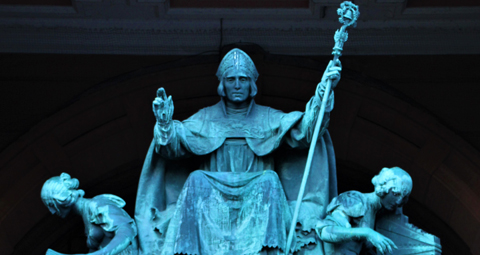January 11 | ![]() 0 COMMENTS
0 COMMENTS ![]() print
print

Signs of St Mungo can be found in Glasgow – if you know where to look
Signs remain, High Dougherty finds, of the Catholic roots of Scotland’s largest city.
When I was a wee boy in the 1950s, I bumped into St Mungo every day.
That’s because, as you waited for a Glasgow Corporation tram, trolleybus or bus, you couldn’t help noticing the saint, dressed as a bishop, looking at you as the vehicle drew up at your stop.
There he was, right at the top of the city coat of arms carried proudly by every corporation vehicle in those days.
Today, as we near St Mungo’s annual feast on January 13, is the city’s patron saint as visible as he was then? Where are you likely to encounter him in his own city?
If you want to see that superb, Glasgow Corporation armorial insignia, you’ll have to go to the city’s Riverside Museum, where he’s to be found on the superb examples of trams, buses and one trolleybus displayed there.
The remarkable fact is that Glasgow Corporation chose the saint at all for its coat of arms, for it wasn’t until 1866 that it approached the Lord Lyon of Arms with the design.
In those days, the corporation was a firmly Protestant, Masonic institution, with no sign of a Catholic councillor—this was just 18 years after the Irish influx after the famine.
So it’s not clear why they chose a saint and symbols illustrating St Mungo’s early miracles, along with his motto: “Let Glasgow Flourish by the Preaching of the Word.” It was a rather non-ecumenical time in a Scotland which didn’t rate saints greatly.
But choose it they did, and it’s a variant of those arms that the current Glasgow City Council uses, and you’ll see it on the council website, on letters and in plenty of other places, although, as the council doesn’t run public transport anymore, poor old St Mungo has been relegated to the bin lorries, not forgetting some street bins in the city centre, too!
You will, however, find that saint has a presence in the most unexpected places: looking down, for example, on the traffic below the former Glasgow Savings Bank building in Ingram Street.
The statue was placed there by the Victorian builders, perhaps to safeguard the institution, as Glasgow banks had a nasty habit of going bust in those days—and never today, of course!
Take the back entrance into Kelvingrove Museum, and St Mungo sits atop the doors, and, go into any of the galleries, and, when you need a sit-down, relax on one of the original wooden benches.
They’re graced, you might have guessed, by a carving of the city’s coat of arms, with St Mungo very much to the fore.
Of course, St Mungo is to be found in the names of St Mungo Academy, St Mungo’s Primary School and St Mungo’s Church, not forgetting the St Mungo Museum of Religion on High Street, so no one can say that the city has forgotten its patron saint.
And neither should it, for the single most visible symbol of his life and times is Glasgow Cathedral, which, thankfully, just survived the onslaught of the religious revolutionaries of what many call The Reformation, to be with us today.
What didn’t survive was the magnificent tomb of St Mungo and the busy pilgrimage trade that it attracted in the middle ages, but you can still go down to the crypt to the spot where the saint is said to be buried and pray there to the patron of a city that needs his Gospel values so much, these days.
It’s remarkable, though, despite St Mungo being so visible in names of institutions, statues on buildings and on the city’s insignia, and despite the best efforts of Glasgow Churches Together and the organisers of the St Mungo Festival, which runs events around the time of his January feast day, that St Mungo isn’t really well-known in Glasgow.
For, when many people think of Glasgow’s saint, they recall St John Ogilvie, yet St Mungo, who set up the community that developed into Glasgow round his church, had a much greater and more lasting influence on the city.
Maybe it’s because he was a Fifer: his mother St Enoch—recalled by the name of St Enoch’s shopping centre— delivered Mungo in Culross.
That may be why Weegies find him hard to relate to! Or it could simply be that the long-established practice of veneration died out with the ravages of the religious revolution of the 16th century, when Mungo was decreed, along with the concept of saints, to be too popish to survive.
Maybe that’s why you don’t come across many local lads called Mungo today, although there was the famous African explorer, Mungo Park, who proudly used the name, despite the fact that he came from Selkirkshire.
So, today, as we prepare to celebrate St Mungo’s feast day, 1,405 years after his death in 614AD, it’s time to open our own eyes to this important saint’s presence.
It’s even more important to open the eyes of fellow citizens, and all who come to Glasgow for work, shopping or relaxation, to the fact that Glasgow is St Mungo’s city, founded on the words of the Gospel, a Gospel which it needs to listen to, believe in and act on. As Mungo put it: “By the preaching of the Word.”










